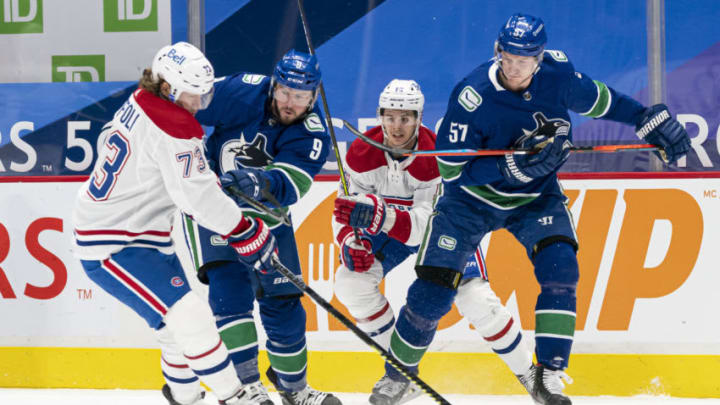The Vancouver Canucks still have a ways to go before they’ll have what it takes to be a playoff team.
Or do they?
Despite finishing dead last in the Scotia North Division, the Canucks were only nine points behind the Montreal Canadiens for the fourth and final playoff spot. As we all know, the Canadiens have taken full advantage of their postseason appearance, and are now representing Canada in the final four. They’ll need to bounce back in a big way to try and tie up their series with the Vegas Golden Knights, but we’ve seen crazier events happen during these playoffs, so it’s still a possibility, albeit a slim one.
Yes, it’s hard to truly analyze where the Canucks in the standings, given the landscape of the league this year, and how the all-Canadian division actually panned out, especially in comparison with the skillset and intensity of the other three divisions. The Canucks have some pretty deep flaws that need to be addressed, and this writer will be one of the first to admit that.
But, given how the Canadiens closed off the regular season, and where they are now, it begs the question – could the Canucks actually be a decent comparison to the Canadiens at this point?
So, naturally, it only makes sense that we wrap up this editorial series with defencemen for Part 3.
Defencemen
Let’s go back to the on-paper comparison for this one, much like we did for the forwards.
As we know, the Canucks currently have three defencemen on their roster (Alex Edler, Tyler Myers and Travis Hamonic) that are 30 years or older, with Nate Schmidt also hitting that milestone in July. On the flip side, the team also has a handful of young and promising blueliners. Calder finalist Quinn Hughes leads the pack, with Olli Juolevi, Jack Rathbone and Brogan Rafferty progressing in the wings.
The Canadiens, however, are also in a very similar boat when it comes to their blueline.
Captain Shea Weber will be turning 36 in August, Jeff Petry is halfway to 34, and Ben Chiarot just hit the three-decade milestone in May. Pending UFA Erik Gustafsson is also one year away from 30, as is fellow UFA Jon Merrill, who was also acquired at the deadline, but hasn’t played much since the acquisition. Their young defensive pieces include Alexander Romanov and Cale Fleury, who sit at 21 and 22 years of age.
In fact, based on the projected salary cap, as well as the views and opinions of our valued readers, you might even say that Vancouver’s blueline is better off than Montreal’s in the grand scheme of things. Aside from the Myers and Schmidt contracts, which are set to expire after the 2023-24 and 2024-25 seasons, the Canucks aren’t be committed to any more veteran defencemen as of right now. Both Edler and Hamonic just wrapped up the final year of their current contracts, leaving room for some of the younger defencemen to slot into the lineup if management chooses to go down that route.
Montreal, on the other hand, will be in much more trouble over the next few years, particularly on the right side. Weber still has five seasons remaining on his monster 14-year deal, which he signed with the Nashville Predators back in 2012 after being offer-sheeted by the Philadelphia Flyers five days earlier. He’ll be 41 by the time that contract comes to a close, and will account for a cap hit of just under $8 million every season until then. Oof.
Petry, who inked a new four-year, $25 million contract this past September, will be 37 when his deal wraps up. Petry has been defensively solid on the blueline since coming over from Edmonton at the 2015 trade deadline and, more recently, has put up good numbers on the scoresheet, hitting the 40-point plateau for three consecutive seasons. That being said, it’ll be surprising if Petry can consistently keep this up for four more years, and will likely transform into a liability as opposed to a reliability. Not as big an “oof” as Weber, but he still warrants a cringey reaction.
Yet, despite the disparity between defencemen contracts for these two teams, it still appears that both bluelines were constructed pretty similarly this season in terms of size, speed and youth, which forces us to ask the same question as before – what gives Montreal the edge?
Once again, it’s important to focus on two factors.
The first is the defensive pairings.
